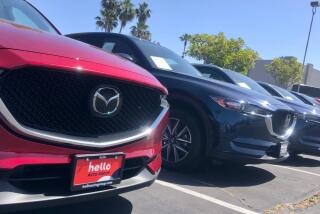U.S. Planning to Certify Side-Impact Air Bags
- Share via
WASHINGTON — Spurred on by several auto makers, the government plans to certify a new generation of air bags aimed at protecting the heads of automobile passengers during side-impact crashes and rollovers.
Roughly 7,700 people are killed in rollovers each year, while 9,200 are seriously injured after being ejected through side windows.
To combat that, BMW is selling its 7-series sedans with a tubular air bag that deploys from the roof above the front doors and from within the front roof pillars.
Next month, Mercedes-Benz will begin offering its E-class sedans with a curtain-style, roof-mounted air bag. Like a model already offered by Volvo, it will extend over the windows beside the driver and front passenger, keeping them in the vehicle, buffering their heads from outside objects and shielding them from spraying glass.
American auto makers are also bringing similar technology to market starting with this fall’s new model year.
The problem is that manufacturers have been moving so fast with improvements, the government has to catch up. The National Highway Traffic Safety Administration had been set to implement a new head protection rule on Sept. 1 that required auto makers to add padding to the roof and roof pillars of new automobiles.
Instead, Transportation Secretary Rodney Slater planned to announce today that the government was expanding the standards so the new air bags would satisfy the requirements. Safety officials believe that may prompt even more auto makers to adopt what is viewed as a superior technology.
Air bags that deploy in front of passengers have been mandatory equipment in cars and light trucks since the 1998 model year, which is just ending. Some auto makers have moved beyond that, placing air bags in the doors and seats of their vehicles to provide side-impact protection.
The head air bags are designed to close a gap in the protection system.






